Australian Economy Analysis Report: 2015-2019 Performance Review
VerifiedAdded on 2022/08/14
|11
|2121
|16
Report
AI Summary
This report provides a comprehensive analysis of the Australian economy, evaluating its performance from 2015 to 2019. The analysis focuses on key macroeconomic indicators including economic growth (GDP), unemployment, inflation, and trade (current account, terms of trade, net foreign debt, and exchange rate). The report compares the recorded figures in the most recent period (2019) with the data from 2015 to identify trends and assess the overall economic progress. The findings indicate a slower pace of economic growth, attributed to declines in consumption spending and housing market slowdown. Unemployment continues to decline, while inflation remains below the target range. The report also assesses Australia's international trade position, highlighting an improvement in terms of trade, currency depreciation, and an improved current account balance. The analysis concludes by identifying three major issues currently facing the Australian economy: slow economic growth, volatility in the housing market, and stagnant wage growth, explaining their implications and concerns for the future economic outlook. The report's structure includes an introduction, analysis of the economic indicators, identification of issues, and a conclusion that summarizes the findings and their implications.
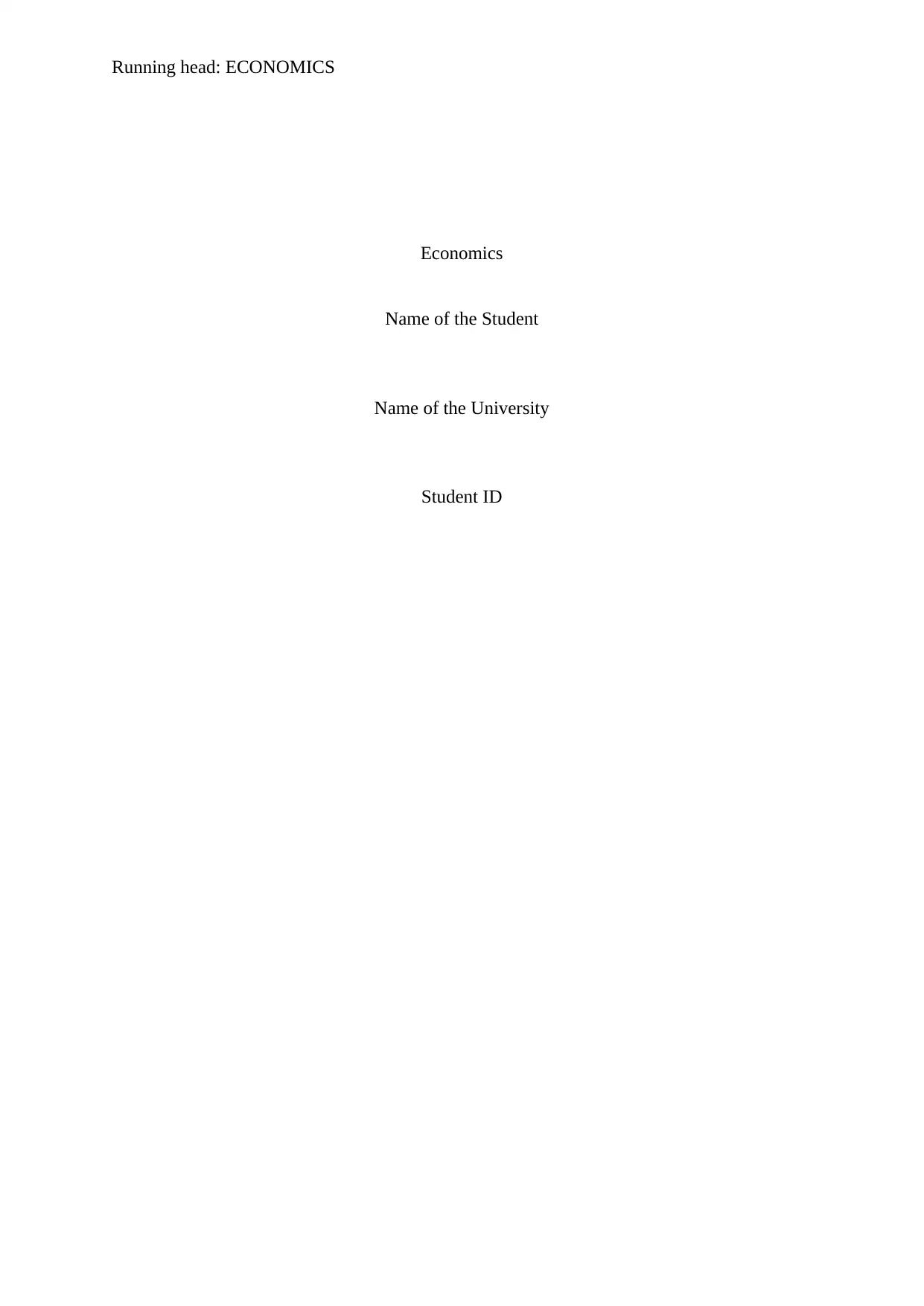
Running head: ECONOMICS
Economics
Name of the Student
Name of the University
Student ID
Economics
Name of the Student
Name of the University
Student ID
Paraphrase This Document
Need a fresh take? Get an instant paraphrase of this document with our AI Paraphraser
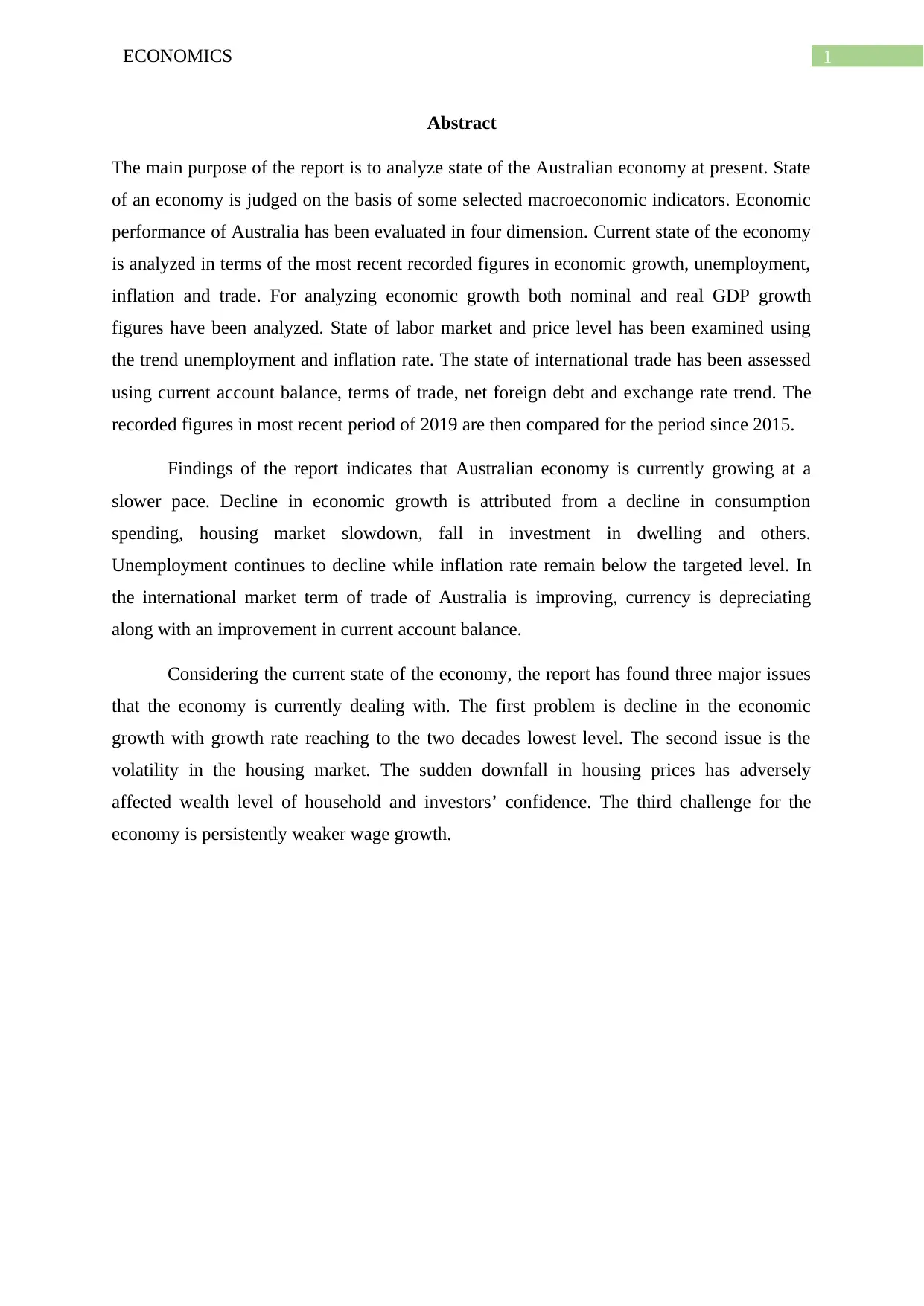
1ECONOMICS
Abstract
The main purpose of the report is to analyze state of the Australian economy at present. State
of an economy is judged on the basis of some selected macroeconomic indicators. Economic
performance of Australia has been evaluated in four dimension. Current state of the economy
is analyzed in terms of the most recent recorded figures in economic growth, unemployment,
inflation and trade. For analyzing economic growth both nominal and real GDP growth
figures have been analyzed. State of labor market and price level has been examined using
the trend unemployment and inflation rate. The state of international trade has been assessed
using current account balance, terms of trade, net foreign debt and exchange rate trend. The
recorded figures in most recent period of 2019 are then compared for the period since 2015.
Findings of the report indicates that Australian economy is currently growing at a
slower pace. Decline in economic growth is attributed from a decline in consumption
spending, housing market slowdown, fall in investment in dwelling and others.
Unemployment continues to decline while inflation rate remain below the targeted level. In
the international market term of trade of Australia is improving, currency is depreciating
along with an improvement in current account balance.
Considering the current state of the economy, the report has found three major issues
that the economy is currently dealing with. The first problem is decline in the economic
growth with growth rate reaching to the two decades lowest level. The second issue is the
volatility in the housing market. The sudden downfall in housing prices has adversely
affected wealth level of household and investors’ confidence. The third challenge for the
economy is persistently weaker wage growth.
Abstract
The main purpose of the report is to analyze state of the Australian economy at present. State
of an economy is judged on the basis of some selected macroeconomic indicators. Economic
performance of Australia has been evaluated in four dimension. Current state of the economy
is analyzed in terms of the most recent recorded figures in economic growth, unemployment,
inflation and trade. For analyzing economic growth both nominal and real GDP growth
figures have been analyzed. State of labor market and price level has been examined using
the trend unemployment and inflation rate. The state of international trade has been assessed
using current account balance, terms of trade, net foreign debt and exchange rate trend. The
recorded figures in most recent period of 2019 are then compared for the period since 2015.
Findings of the report indicates that Australian economy is currently growing at a
slower pace. Decline in economic growth is attributed from a decline in consumption
spending, housing market slowdown, fall in investment in dwelling and others.
Unemployment continues to decline while inflation rate remain below the targeted level. In
the international market term of trade of Australia is improving, currency is depreciating
along with an improvement in current account balance.
Considering the current state of the economy, the report has found three major issues
that the economy is currently dealing with. The first problem is decline in the economic
growth with growth rate reaching to the two decades lowest level. The second issue is the
volatility in the housing market. The sudden downfall in housing prices has adversely
affected wealth level of household and investors’ confidence. The third challenge for the
economy is persistently weaker wage growth.
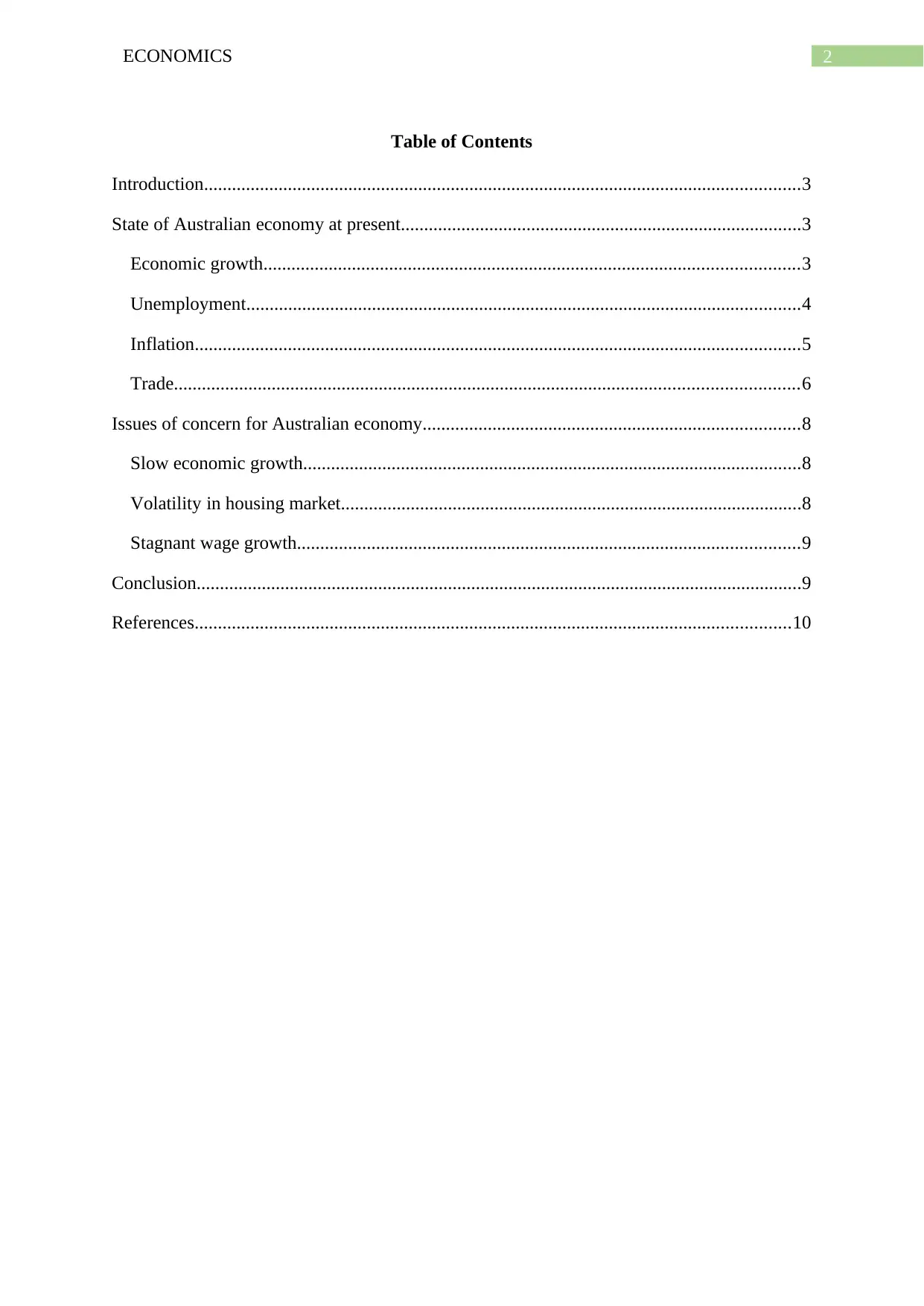
2ECONOMICS
Table of Contents
Introduction................................................................................................................................3
State of Australian economy at present......................................................................................3
Economic growth...................................................................................................................3
Unemployment.......................................................................................................................4
Inflation..................................................................................................................................5
Trade......................................................................................................................................6
Issues of concern for Australian economy.................................................................................8
Slow economic growth...........................................................................................................8
Volatility in housing market...................................................................................................8
Stagnant wage growth............................................................................................................9
Conclusion..................................................................................................................................9
References................................................................................................................................10
Table of Contents
Introduction................................................................................................................................3
State of Australian economy at present......................................................................................3
Economic growth...................................................................................................................3
Unemployment.......................................................................................................................4
Inflation..................................................................................................................................5
Trade......................................................................................................................................6
Issues of concern for Australian economy.................................................................................8
Slow economic growth...........................................................................................................8
Volatility in housing market...................................................................................................8
Stagnant wage growth............................................................................................................9
Conclusion..................................................................................................................................9
References................................................................................................................................10
⊘ This is a preview!⊘
Do you want full access?
Subscribe today to unlock all pages.

Trusted by 1+ million students worldwide
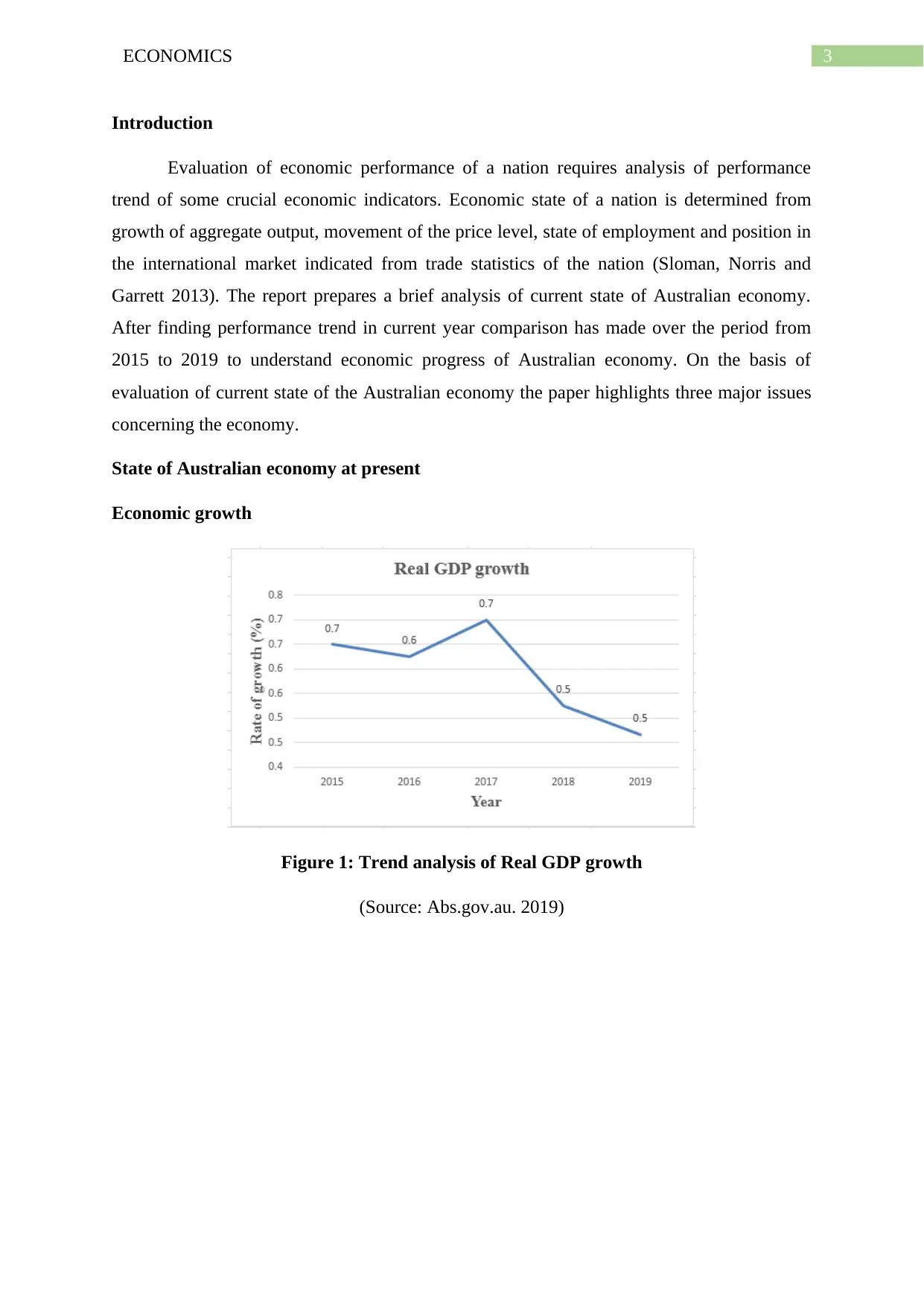
3ECONOMICS
Introduction
Evaluation of economic performance of a nation requires analysis of performance
trend of some crucial economic indicators. Economic state of a nation is determined from
growth of aggregate output, movement of the price level, state of employment and position in
the international market indicated from trade statistics of the nation (Sloman, Norris and
Garrett 2013). The report prepares a brief analysis of current state of Australian economy.
After finding performance trend in current year comparison has made over the period from
2015 to 2019 to understand economic progress of Australian economy. On the basis of
evaluation of current state of the Australian economy the paper highlights three major issues
concerning the economy.
State of Australian economy at present
Economic growth
Figure 1: Trend analysis of Real GDP growth
(Source: Abs.gov.au. 2019)
Introduction
Evaluation of economic performance of a nation requires analysis of performance
trend of some crucial economic indicators. Economic state of a nation is determined from
growth of aggregate output, movement of the price level, state of employment and position in
the international market indicated from trade statistics of the nation (Sloman, Norris and
Garrett 2013). The report prepares a brief analysis of current state of Australian economy.
After finding performance trend in current year comparison has made over the period from
2015 to 2019 to understand economic progress of Australian economy. On the basis of
evaluation of current state of the Australian economy the paper highlights three major issues
concerning the economy.
State of Australian economy at present
Economic growth
Figure 1: Trend analysis of Real GDP growth
(Source: Abs.gov.au. 2019)
Paraphrase This Document
Need a fresh take? Get an instant paraphrase of this document with our AI Paraphraser
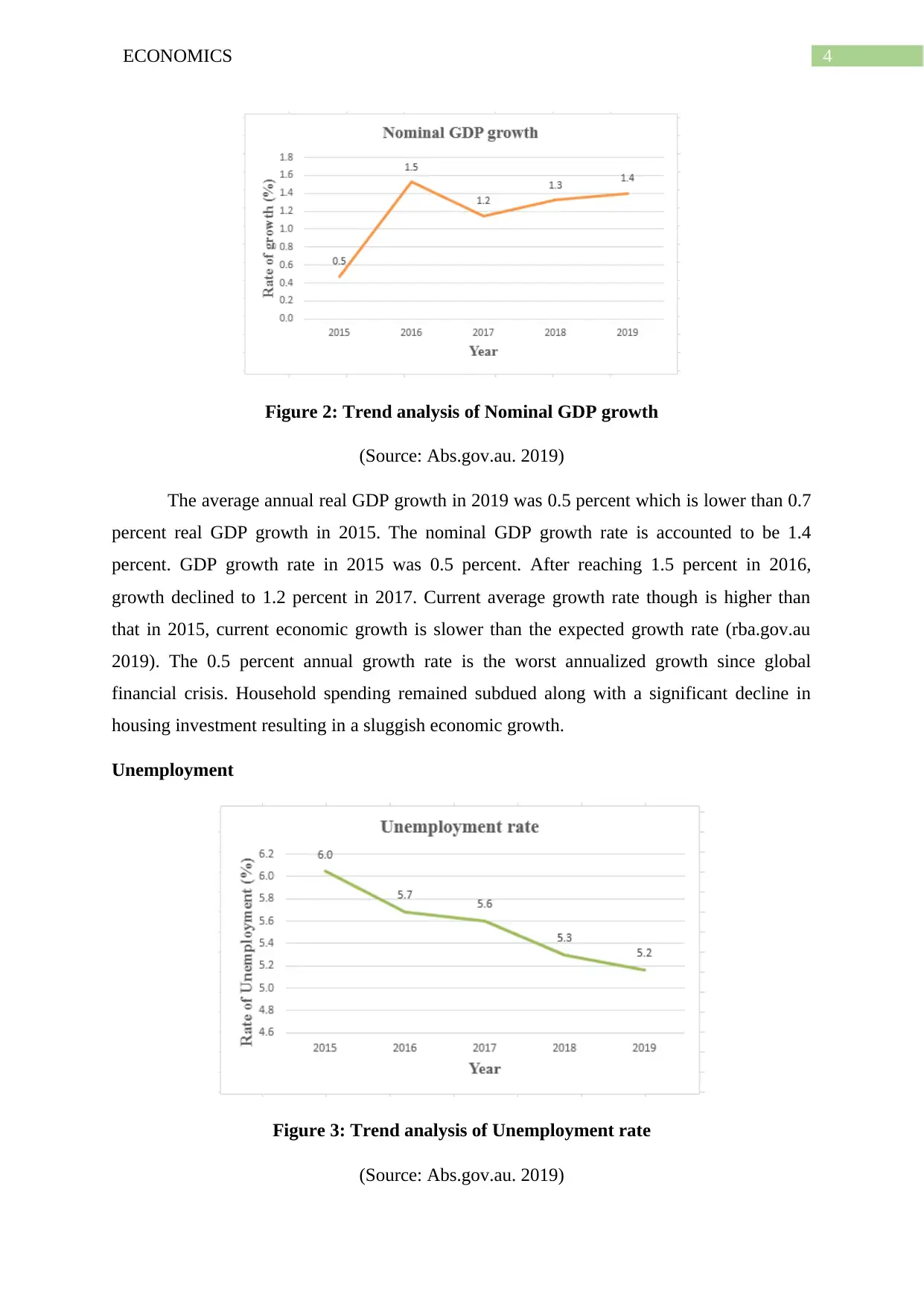
4ECONOMICS
Figure 2: Trend analysis of Nominal GDP growth
(Source: Abs.gov.au. 2019)
The average annual real GDP growth in 2019 was 0.5 percent which is lower than 0.7
percent real GDP growth in 2015. The nominal GDP growth rate is accounted to be 1.4
percent. GDP growth rate in 2015 was 0.5 percent. After reaching 1.5 percent in 2016,
growth declined to 1.2 percent in 2017. Current average growth rate though is higher than
that in 2015, current economic growth is slower than the expected growth rate (rba.gov.au
2019). The 0.5 percent annual growth rate is the worst annualized growth since global
financial crisis. Household spending remained subdued along with a significant decline in
housing investment resulting in a sluggish economic growth.
Unemployment
Figure 3: Trend analysis of Unemployment rate
(Source: Abs.gov.au. 2019)
Figure 2: Trend analysis of Nominal GDP growth
(Source: Abs.gov.au. 2019)
The average annual real GDP growth in 2019 was 0.5 percent which is lower than 0.7
percent real GDP growth in 2015. The nominal GDP growth rate is accounted to be 1.4
percent. GDP growth rate in 2015 was 0.5 percent. After reaching 1.5 percent in 2016,
growth declined to 1.2 percent in 2017. Current average growth rate though is higher than
that in 2015, current economic growth is slower than the expected growth rate (rba.gov.au
2019). The 0.5 percent annual growth rate is the worst annualized growth since global
financial crisis. Household spending remained subdued along with a significant decline in
housing investment resulting in a sluggish economic growth.
Unemployment
Figure 3: Trend analysis of Unemployment rate
(Source: Abs.gov.au. 2019)
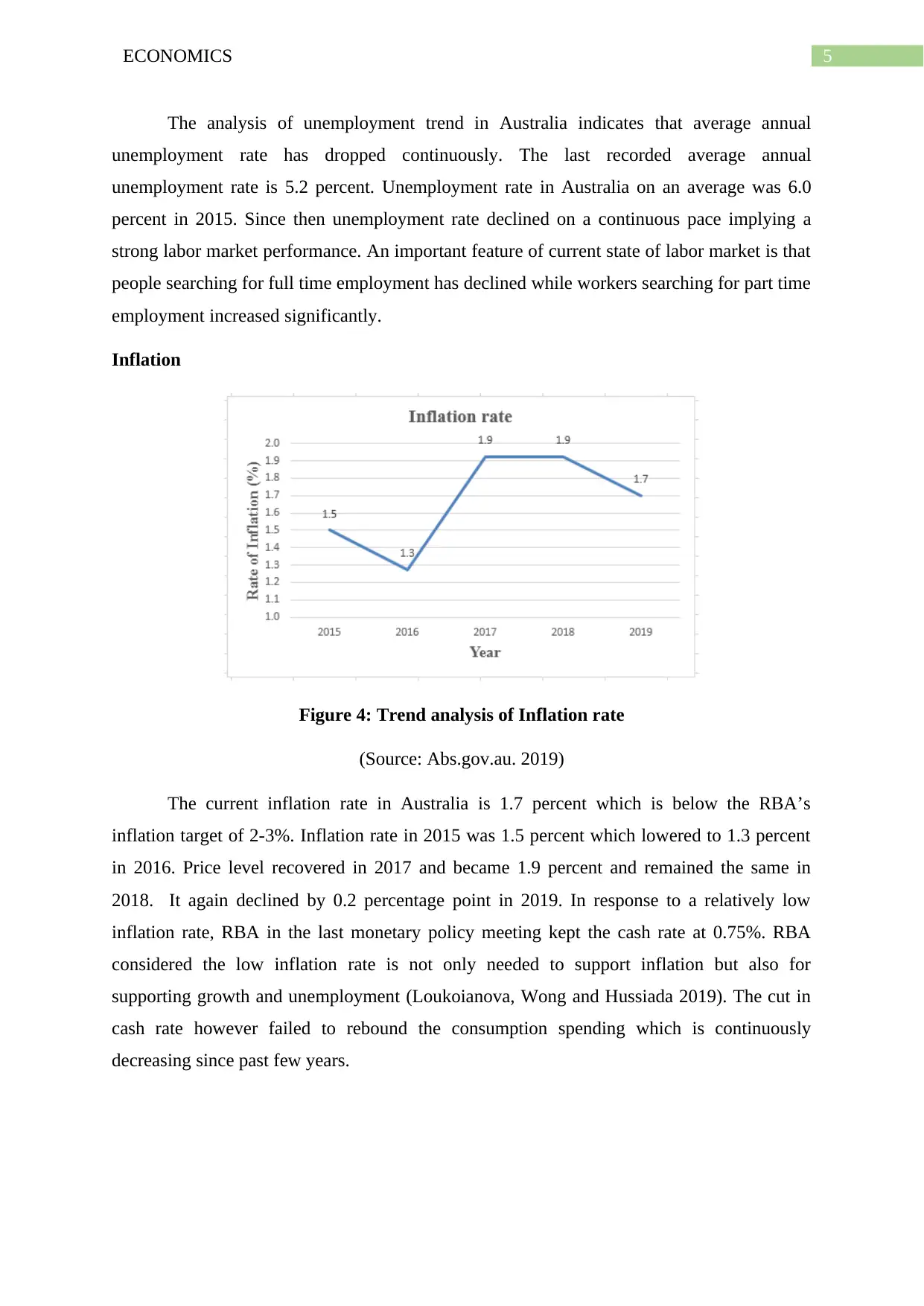
5ECONOMICS
The analysis of unemployment trend in Australia indicates that average annual
unemployment rate has dropped continuously. The last recorded average annual
unemployment rate is 5.2 percent. Unemployment rate in Australia on an average was 6.0
percent in 2015. Since then unemployment rate declined on a continuous pace implying a
strong labor market performance. An important feature of current state of labor market is that
people searching for full time employment has declined while workers searching for part time
employment increased significantly.
Inflation
Figure 4: Trend analysis of Inflation rate
(Source: Abs.gov.au. 2019)
The current inflation rate in Australia is 1.7 percent which is below the RBA’s
inflation target of 2-3%. Inflation rate in 2015 was 1.5 percent which lowered to 1.3 percent
in 2016. Price level recovered in 2017 and became 1.9 percent and remained the same in
2018. It again declined by 0.2 percentage point in 2019. In response to a relatively low
inflation rate, RBA in the last monetary policy meeting kept the cash rate at 0.75%. RBA
considered the low inflation rate is not only needed to support inflation but also for
supporting growth and unemployment (Loukoianova, Wong and Hussiada 2019). The cut in
cash rate however failed to rebound the consumption spending which is continuously
decreasing since past few years.
The analysis of unemployment trend in Australia indicates that average annual
unemployment rate has dropped continuously. The last recorded average annual
unemployment rate is 5.2 percent. Unemployment rate in Australia on an average was 6.0
percent in 2015. Since then unemployment rate declined on a continuous pace implying a
strong labor market performance. An important feature of current state of labor market is that
people searching for full time employment has declined while workers searching for part time
employment increased significantly.
Inflation
Figure 4: Trend analysis of Inflation rate
(Source: Abs.gov.au. 2019)
The current inflation rate in Australia is 1.7 percent which is below the RBA’s
inflation target of 2-3%. Inflation rate in 2015 was 1.5 percent which lowered to 1.3 percent
in 2016. Price level recovered in 2017 and became 1.9 percent and remained the same in
2018. It again declined by 0.2 percentage point in 2019. In response to a relatively low
inflation rate, RBA in the last monetary policy meeting kept the cash rate at 0.75%. RBA
considered the low inflation rate is not only needed to support inflation but also for
supporting growth and unemployment (Loukoianova, Wong and Hussiada 2019). The cut in
cash rate however failed to rebound the consumption spending which is continuously
decreasing since past few years.
⊘ This is a preview!⊘
Do you want full access?
Subscribe today to unlock all pages.

Trusted by 1+ million students worldwide
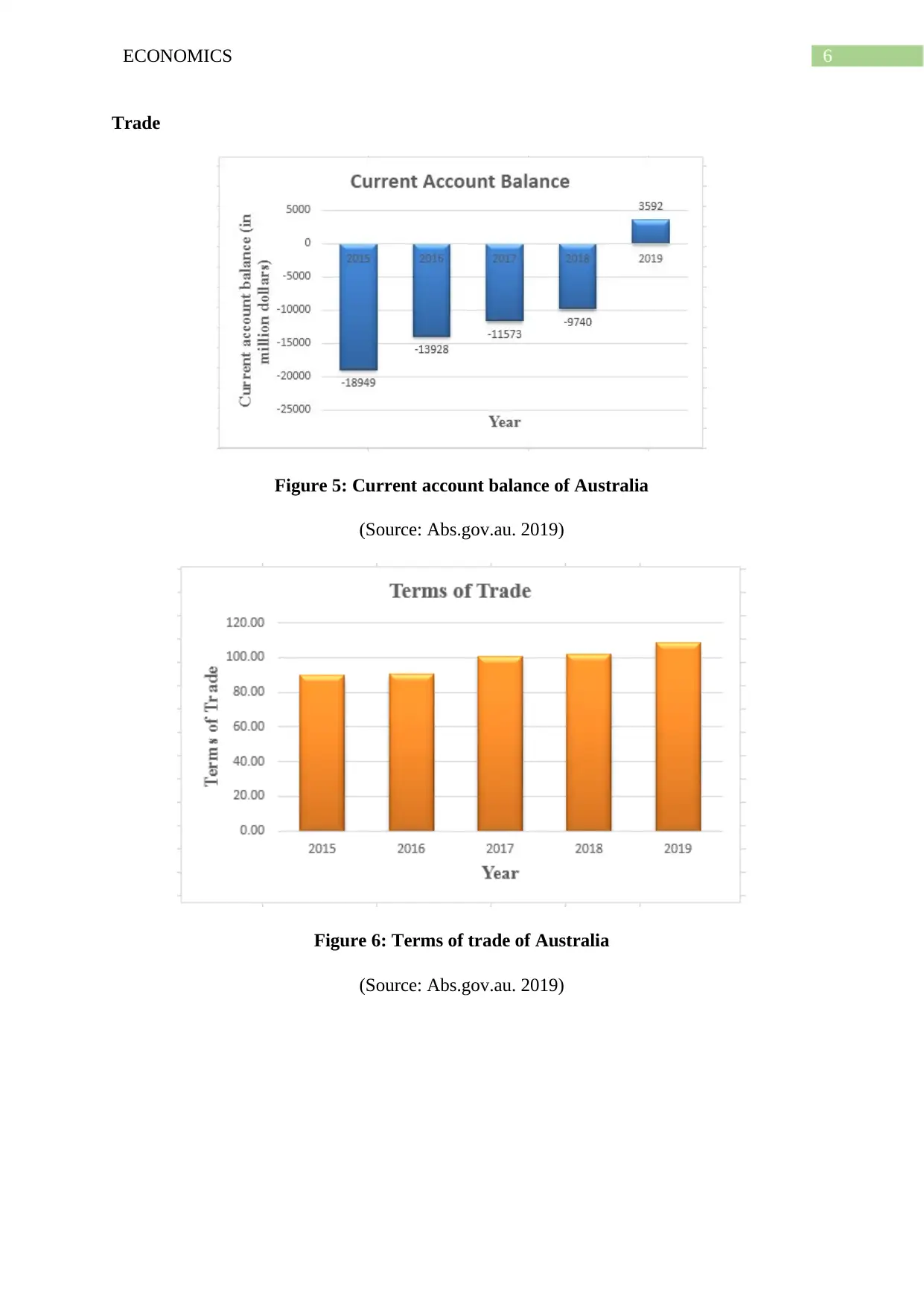
6ECONOMICS
Trade
Figure 5: Current account balance of Australia
(Source: Abs.gov.au. 2019)
Figure 6: Terms of trade of Australia
(Source: Abs.gov.au. 2019)
Trade
Figure 5: Current account balance of Australia
(Source: Abs.gov.au. 2019)
Figure 6: Terms of trade of Australia
(Source: Abs.gov.au. 2019)
Paraphrase This Document
Need a fresh take? Get an instant paraphrase of this document with our AI Paraphraser
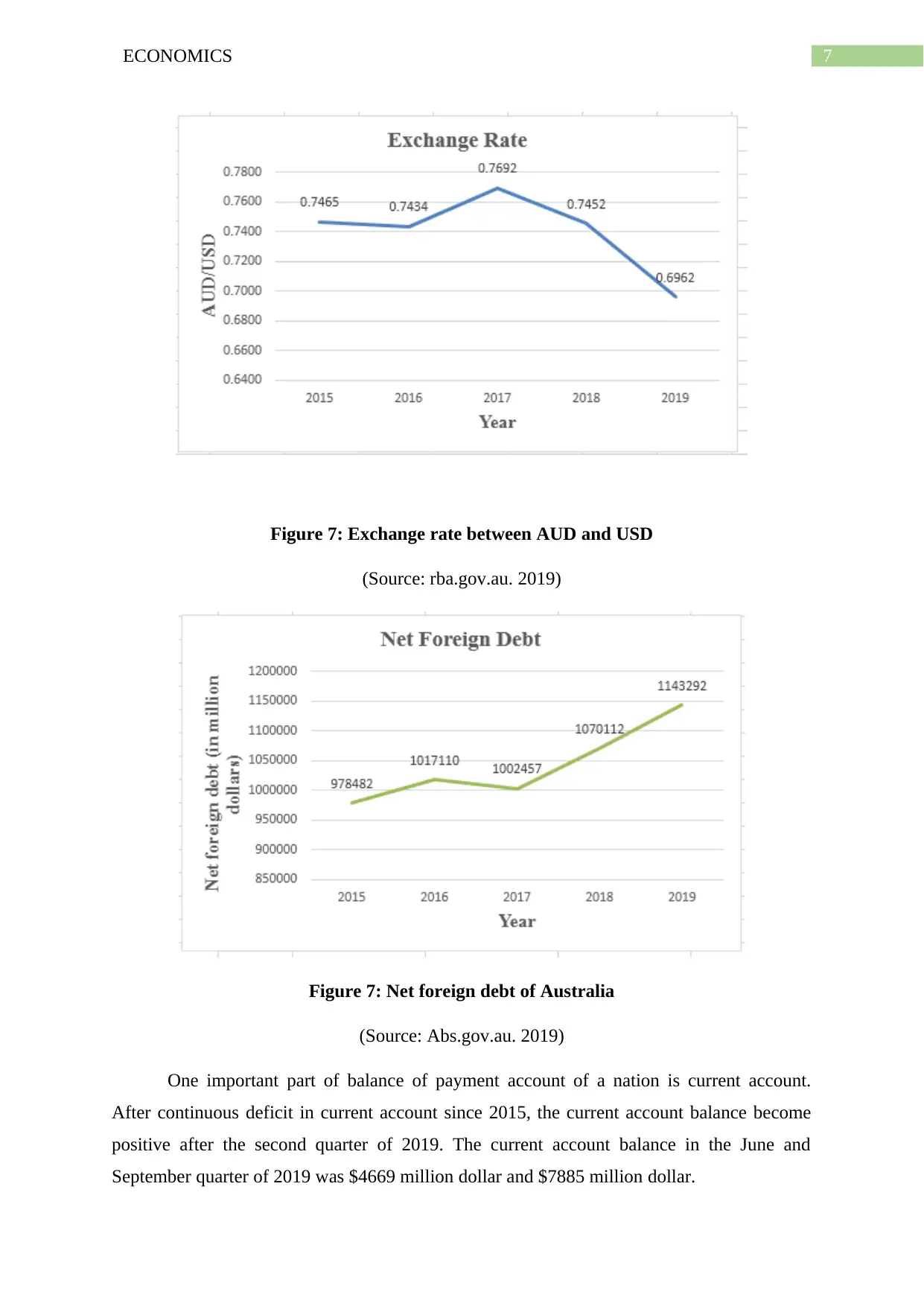
7ECONOMICS
Figure 7: Exchange rate between AUD and USD
(Source: rba.gov.au. 2019)
Figure 7: Net foreign debt of Australia
(Source: Abs.gov.au. 2019)
One important part of balance of payment account of a nation is current account.
After continuous deficit in current account since 2015, the current account balance become
positive after the second quarter of 2019. The current account balance in the June and
September quarter of 2019 was $4669 million dollar and $7885 million dollar.
Figure 7: Exchange rate between AUD and USD
(Source: rba.gov.au. 2019)
Figure 7: Net foreign debt of Australia
(Source: Abs.gov.au. 2019)
One important part of balance of payment account of a nation is current account.
After continuous deficit in current account since 2015, the current account balance become
positive after the second quarter of 2019. The current account balance in the June and
September quarter of 2019 was $4669 million dollar and $7885 million dollar.
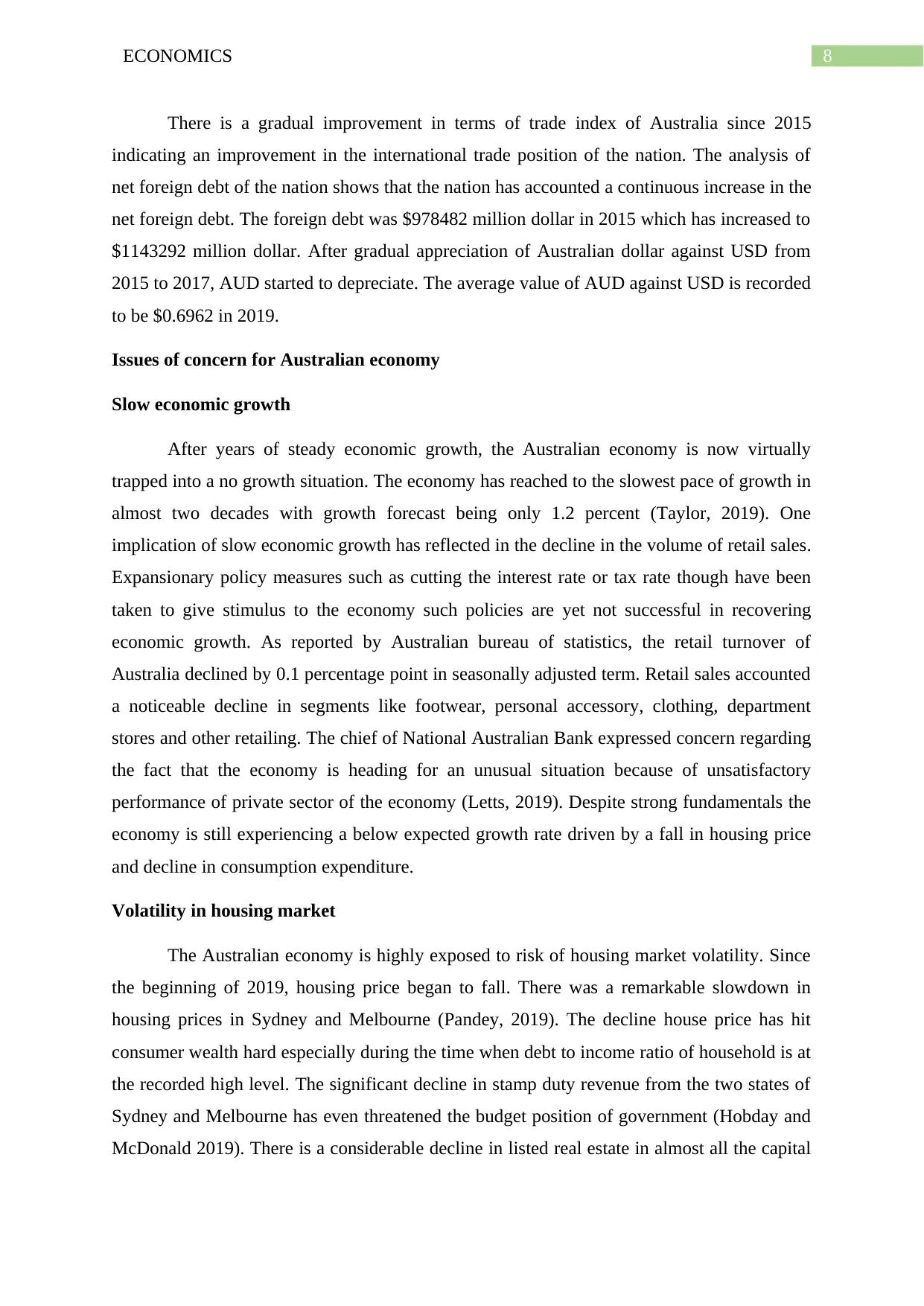
8ECONOMICS
There is a gradual improvement in terms of trade index of Australia since 2015
indicating an improvement in the international trade position of the nation. The analysis of
net foreign debt of the nation shows that the nation has accounted a continuous increase in the
net foreign debt. The foreign debt was $978482 million dollar in 2015 which has increased to
$1143292 million dollar. After gradual appreciation of Australian dollar against USD from
2015 to 2017, AUD started to depreciate. The average value of AUD against USD is recorded
to be $0.6962 in 2019.
Issues of concern for Australian economy
Slow economic growth
After years of steady economic growth, the Australian economy is now virtually
trapped into a no growth situation. The economy has reached to the slowest pace of growth in
almost two decades with growth forecast being only 1.2 percent (Taylor, 2019). One
implication of slow economic growth has reflected in the decline in the volume of retail sales.
Expansionary policy measures such as cutting the interest rate or tax rate though have been
taken to give stimulus to the economy such policies are yet not successful in recovering
economic growth. As reported by Australian bureau of statistics, the retail turnover of
Australia declined by 0.1 percentage point in seasonally adjusted term. Retail sales accounted
a noticeable decline in segments like footwear, personal accessory, clothing, department
stores and other retailing. The chief of National Australian Bank expressed concern regarding
the fact that the economy is heading for an unusual situation because of unsatisfactory
performance of private sector of the economy (Letts, 2019). Despite strong fundamentals the
economy is still experiencing a below expected growth rate driven by a fall in housing price
and decline in consumption expenditure.
Volatility in housing market
The Australian economy is highly exposed to risk of housing market volatility. Since
the beginning of 2019, housing price began to fall. There was a remarkable slowdown in
housing prices in Sydney and Melbourne (Pandey, 2019). The decline house price has hit
consumer wealth hard especially during the time when debt to income ratio of household is at
the recorded high level. The significant decline in stamp duty revenue from the two states of
Sydney and Melbourne has even threatened the budget position of government (Hobday and
McDonald 2019). There is a considerable decline in listed real estate in almost all the capital
There is a gradual improvement in terms of trade index of Australia since 2015
indicating an improvement in the international trade position of the nation. The analysis of
net foreign debt of the nation shows that the nation has accounted a continuous increase in the
net foreign debt. The foreign debt was $978482 million dollar in 2015 which has increased to
$1143292 million dollar. After gradual appreciation of Australian dollar against USD from
2015 to 2017, AUD started to depreciate. The average value of AUD against USD is recorded
to be $0.6962 in 2019.
Issues of concern for Australian economy
Slow economic growth
After years of steady economic growth, the Australian economy is now virtually
trapped into a no growth situation. The economy has reached to the slowest pace of growth in
almost two decades with growth forecast being only 1.2 percent (Taylor, 2019). One
implication of slow economic growth has reflected in the decline in the volume of retail sales.
Expansionary policy measures such as cutting the interest rate or tax rate though have been
taken to give stimulus to the economy such policies are yet not successful in recovering
economic growth. As reported by Australian bureau of statistics, the retail turnover of
Australia declined by 0.1 percentage point in seasonally adjusted term. Retail sales accounted
a noticeable decline in segments like footwear, personal accessory, clothing, department
stores and other retailing. The chief of National Australian Bank expressed concern regarding
the fact that the economy is heading for an unusual situation because of unsatisfactory
performance of private sector of the economy (Letts, 2019). Despite strong fundamentals the
economy is still experiencing a below expected growth rate driven by a fall in housing price
and decline in consumption expenditure.
Volatility in housing market
The Australian economy is highly exposed to risk of housing market volatility. Since
the beginning of 2019, housing price began to fall. There was a remarkable slowdown in
housing prices in Sydney and Melbourne (Pandey, 2019). The decline house price has hit
consumer wealth hard especially during the time when debt to income ratio of household is at
the recorded high level. The significant decline in stamp duty revenue from the two states of
Sydney and Melbourne has even threatened the budget position of government (Hobday and
McDonald 2019). There is a considerable decline in listed real estate in almost all the capital
⊘ This is a preview!⊘
Do you want full access?
Subscribe today to unlock all pages.

Trusted by 1+ million students worldwide
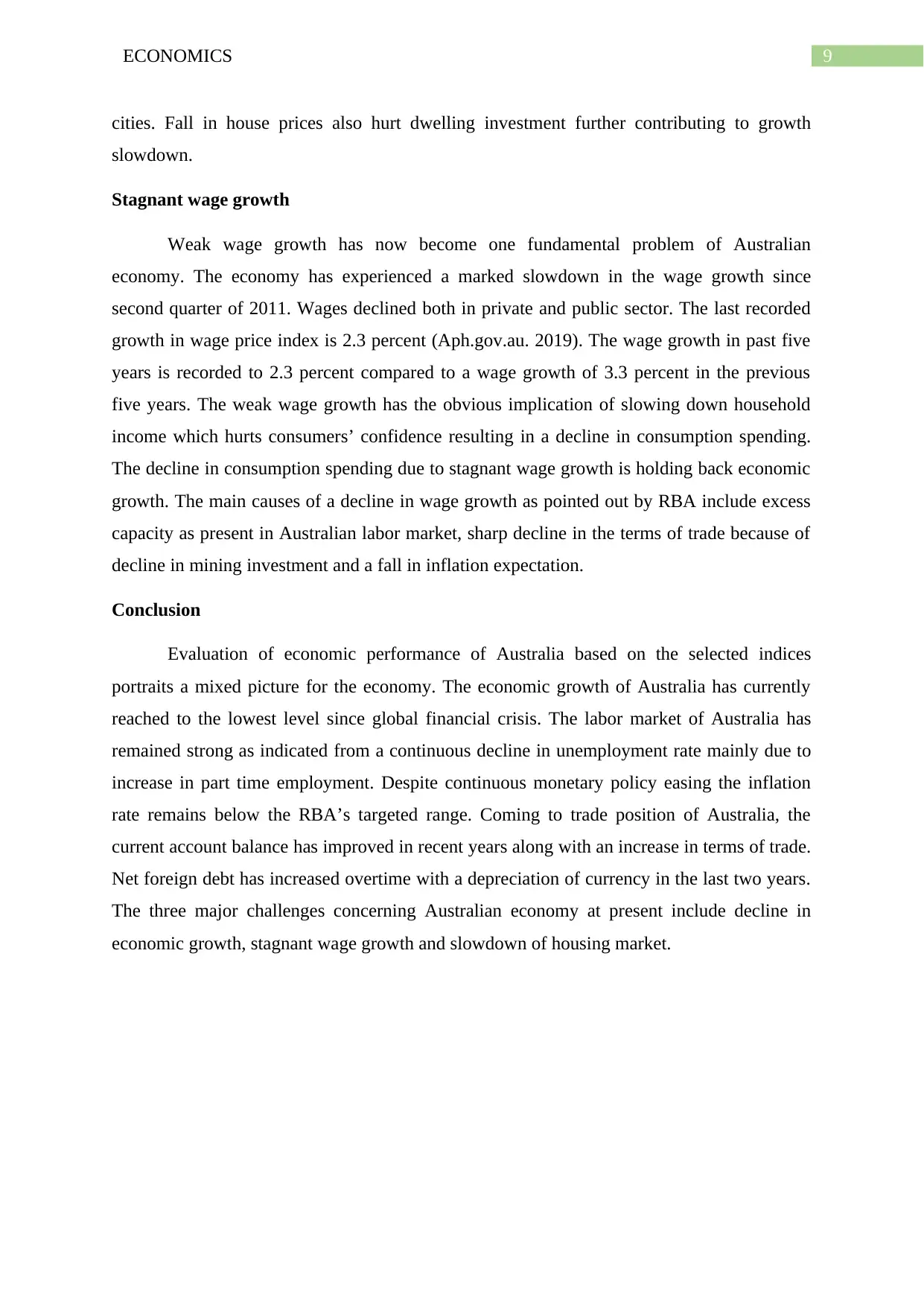
9ECONOMICS
cities. Fall in house prices also hurt dwelling investment further contributing to growth
slowdown.
Stagnant wage growth
Weak wage growth has now become one fundamental problem of Australian
economy. The economy has experienced a marked slowdown in the wage growth since
second quarter of 2011. Wages declined both in private and public sector. The last recorded
growth in wage price index is 2.3 percent (Aph.gov.au. 2019). The wage growth in past five
years is recorded to 2.3 percent compared to a wage growth of 3.3 percent in the previous
five years. The weak wage growth has the obvious implication of slowing down household
income which hurts consumers’ confidence resulting in a decline in consumption spending.
The decline in consumption spending due to stagnant wage growth is holding back economic
growth. The main causes of a decline in wage growth as pointed out by RBA include excess
capacity as present in Australian labor market, sharp decline in the terms of trade because of
decline in mining investment and a fall in inflation expectation.
Conclusion
Evaluation of economic performance of Australia based on the selected indices
portraits a mixed picture for the economy. The economic growth of Australia has currently
reached to the lowest level since global financial crisis. The labor market of Australia has
remained strong as indicated from a continuous decline in unemployment rate mainly due to
increase in part time employment. Despite continuous monetary policy easing the inflation
rate remains below the RBA’s targeted range. Coming to trade position of Australia, the
current account balance has improved in recent years along with an increase in terms of trade.
Net foreign debt has increased overtime with a depreciation of currency in the last two years.
The three major challenges concerning Australian economy at present include decline in
economic growth, stagnant wage growth and slowdown of housing market.
cities. Fall in house prices also hurt dwelling investment further contributing to growth
slowdown.
Stagnant wage growth
Weak wage growth has now become one fundamental problem of Australian
economy. The economy has experienced a marked slowdown in the wage growth since
second quarter of 2011. Wages declined both in private and public sector. The last recorded
growth in wage price index is 2.3 percent (Aph.gov.au. 2019). The wage growth in past five
years is recorded to 2.3 percent compared to a wage growth of 3.3 percent in the previous
five years. The weak wage growth has the obvious implication of slowing down household
income which hurts consumers’ confidence resulting in a decline in consumption spending.
The decline in consumption spending due to stagnant wage growth is holding back economic
growth. The main causes of a decline in wage growth as pointed out by RBA include excess
capacity as present in Australian labor market, sharp decline in the terms of trade because of
decline in mining investment and a fall in inflation expectation.
Conclusion
Evaluation of economic performance of Australia based on the selected indices
portraits a mixed picture for the economy. The economic growth of Australia has currently
reached to the lowest level since global financial crisis. The labor market of Australia has
remained strong as indicated from a continuous decline in unemployment rate mainly due to
increase in part time employment. Despite continuous monetary policy easing the inflation
rate remains below the RBA’s targeted range. Coming to trade position of Australia, the
current account balance has improved in recent years along with an increase in terms of trade.
Net foreign debt has increased overtime with a depreciation of currency in the last two years.
The three major challenges concerning Australian economy at present include decline in
economic growth, stagnant wage growth and slowdown of housing market.
Paraphrase This Document
Need a fresh take? Get an instant paraphrase of this document with our AI Paraphraser
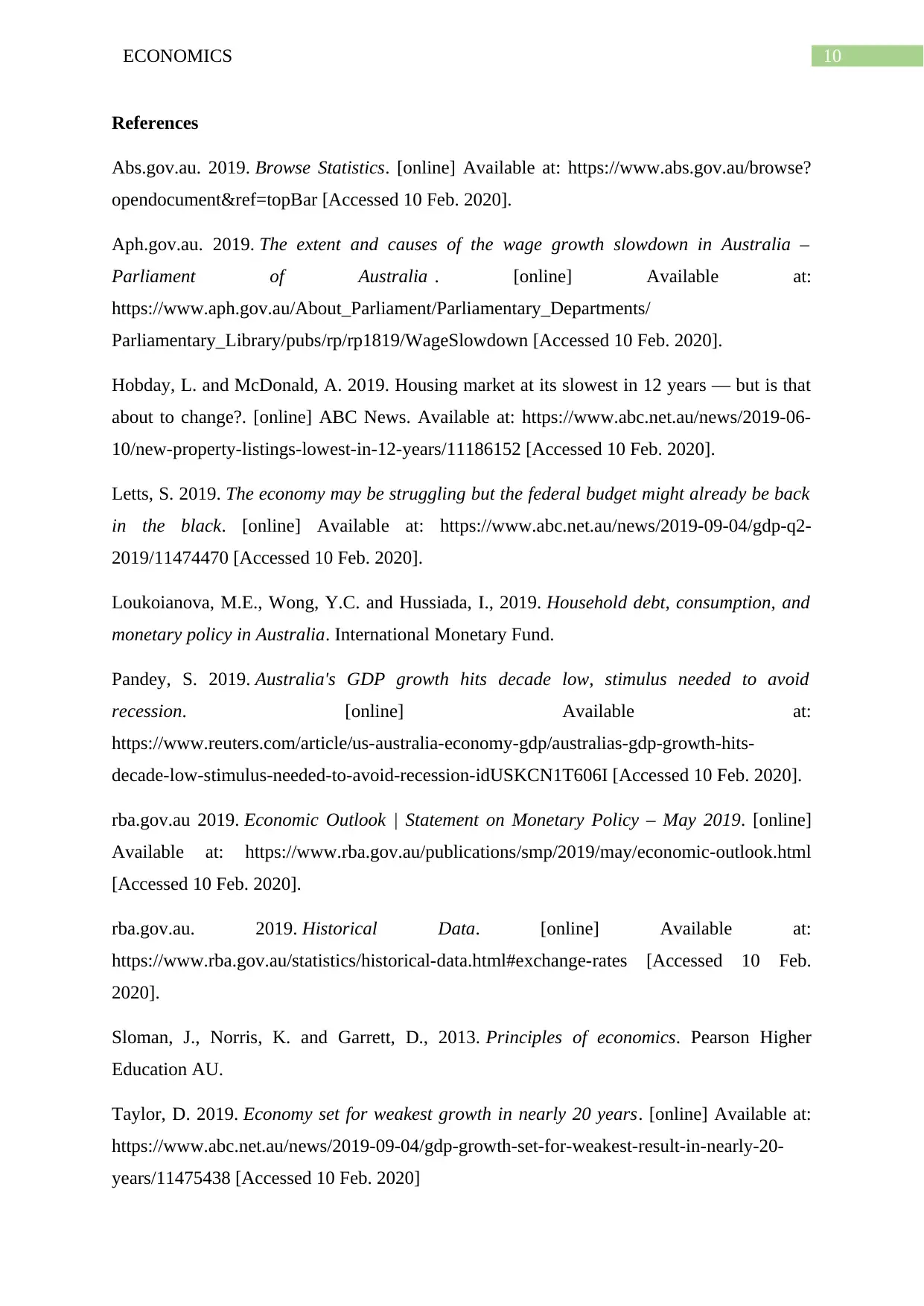
10ECONOMICS
References
Abs.gov.au. 2019. Browse Statistics. [online] Available at: https://www.abs.gov.au/browse?
opendocument&ref=topBar [Accessed 10 Feb. 2020].
Aph.gov.au. 2019. The extent and causes of the wage growth slowdown in Australia –
Parliament of Australia . [online] Available at:
https://www.aph.gov.au/About_Parliament/Parliamentary_Departments/
Parliamentary_Library/pubs/rp/rp1819/WageSlowdown [Accessed 10 Feb. 2020].
Hobday, L. and McDonald, A. 2019. Housing market at its slowest in 12 years — but is that
about to change?. [online] ABC News. Available at: https://www.abc.net.au/news/2019-06-
10/new-property-listings-lowest-in-12-years/11186152 [Accessed 10 Feb. 2020].
Letts, S. 2019. The economy may be struggling but the federal budget might already be back
in the black. [online] Available at: https://www.abc.net.au/news/2019-09-04/gdp-q2-
2019/11474470 [Accessed 10 Feb. 2020].
Loukoianova, M.E., Wong, Y.C. and Hussiada, I., 2019. Household debt, consumption, and
monetary policy in Australia. International Monetary Fund.
Pandey, S. 2019. Australia's GDP growth hits decade low, stimulus needed to avoid
recession. [online] Available at:
https://www.reuters.com/article/us-australia-economy-gdp/australias-gdp-growth-hits-
decade-low-stimulus-needed-to-avoid-recession-idUSKCN1T606I [Accessed 10 Feb. 2020].
rba.gov.au 2019. Economic Outlook | Statement on Monetary Policy – May 2019. [online]
Available at: https://www.rba.gov.au/publications/smp/2019/may/economic-outlook.html
[Accessed 10 Feb. 2020].
rba.gov.au. 2019. Historical Data. [online] Available at:
https://www.rba.gov.au/statistics/historical-data.html#exchange-rates [Accessed 10 Feb.
2020].
Sloman, J., Norris, K. and Garrett, D., 2013. Principles of economics. Pearson Higher
Education AU.
Taylor, D. 2019. Economy set for weakest growth in nearly 20 years. [online] Available at:
https://www.abc.net.au/news/2019-09-04/gdp-growth-set-for-weakest-result-in-nearly-20-
years/11475438 [Accessed 10 Feb. 2020]
References
Abs.gov.au. 2019. Browse Statistics. [online] Available at: https://www.abs.gov.au/browse?
opendocument&ref=topBar [Accessed 10 Feb. 2020].
Aph.gov.au. 2019. The extent and causes of the wage growth slowdown in Australia –
Parliament of Australia . [online] Available at:
https://www.aph.gov.au/About_Parliament/Parliamentary_Departments/
Parliamentary_Library/pubs/rp/rp1819/WageSlowdown [Accessed 10 Feb. 2020].
Hobday, L. and McDonald, A. 2019. Housing market at its slowest in 12 years — but is that
about to change?. [online] ABC News. Available at: https://www.abc.net.au/news/2019-06-
10/new-property-listings-lowest-in-12-years/11186152 [Accessed 10 Feb. 2020].
Letts, S. 2019. The economy may be struggling but the federal budget might already be back
in the black. [online] Available at: https://www.abc.net.au/news/2019-09-04/gdp-q2-
2019/11474470 [Accessed 10 Feb. 2020].
Loukoianova, M.E., Wong, Y.C. and Hussiada, I., 2019. Household debt, consumption, and
monetary policy in Australia. International Monetary Fund.
Pandey, S. 2019. Australia's GDP growth hits decade low, stimulus needed to avoid
recession. [online] Available at:
https://www.reuters.com/article/us-australia-economy-gdp/australias-gdp-growth-hits-
decade-low-stimulus-needed-to-avoid-recession-idUSKCN1T606I [Accessed 10 Feb. 2020].
rba.gov.au 2019. Economic Outlook | Statement on Monetary Policy – May 2019. [online]
Available at: https://www.rba.gov.au/publications/smp/2019/may/economic-outlook.html
[Accessed 10 Feb. 2020].
rba.gov.au. 2019. Historical Data. [online] Available at:
https://www.rba.gov.au/statistics/historical-data.html#exchange-rates [Accessed 10 Feb.
2020].
Sloman, J., Norris, K. and Garrett, D., 2013. Principles of economics. Pearson Higher
Education AU.
Taylor, D. 2019. Economy set for weakest growth in nearly 20 years. [online] Available at:
https://www.abc.net.au/news/2019-09-04/gdp-growth-set-for-weakest-result-in-nearly-20-
years/11475438 [Accessed 10 Feb. 2020]
1 out of 11
Related Documents
Your All-in-One AI-Powered Toolkit for Academic Success.
+13062052269
info@desklib.com
Available 24*7 on WhatsApp / Email
![[object Object]](/_next/static/media/star-bottom.7253800d.svg)
Unlock your academic potential
Copyright © 2020–2025 A2Z Services. All Rights Reserved. Developed and managed by ZUCOL.





